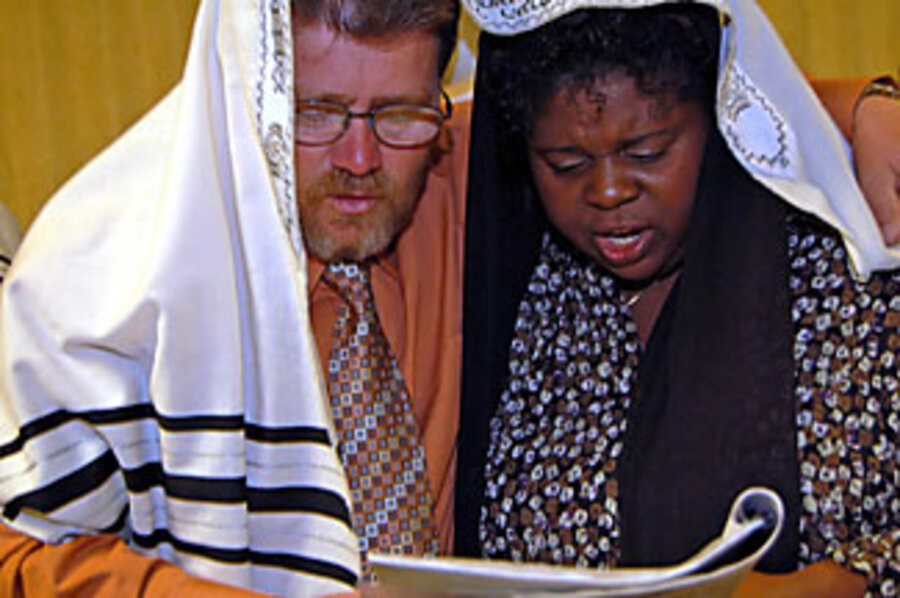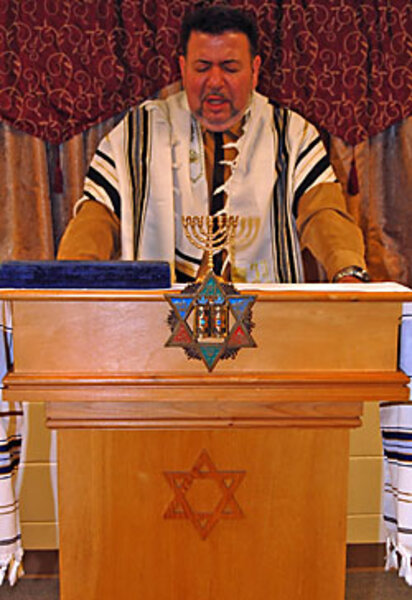Some US Hispanics trace their Jewish past
| Sanford, Fla.
Wendy Martinez Canelones grew up Catholic and Seventh-day Adventist. But she always felt drawn to Judaism. She once had a vivid dream of herself embracing a blue volume of the Torah. She tears up recalling the dream.
Eventually, she found out why. While studying her family history, she found that she is a descendant of Jews who were killed during the Spanish Inquisition.
"It's been in my heart so many years that for me, it was not a surprise," says Ms. Canelones, who converted to Judaism and now worships at Beth Israel Messianic Synagogue, a congregation for Hispanic Jews in suburban Orlando.
So-called hidden or crypto-Jews, whose family histories have been shrouded in secrecy for centuries, can trace their ancestry back to the Sephardic Jews of Spain. Many of them are here in the former Spanish colonies of Florida, as well as the US Southwest, the Caribbean, and Central and South America.
Now, interest is growing in the United States among some Hispanics to probe what may be their Jewish heritage. Family Tree DNA, a Houston-based genetics genealogy company offering a comparative Jewish database, gets dozens of orders a week from Hispanics wanting to know whether they might be Jewish. Of those, two or three test positive, estimates Bennett Greenspan, founder and president of the company.
"What we started to notice in 2000 and particularly in 2001 was a bunch of Hispanics started with us and their DNA was matching to Jews," Mr. Greenspan says. "They were coming to me, saying, 'I knew it. I knew it all along'.... The earlier someone came to the New World as a Hispanic, the more likely they have Jewish ancestry."
No one is sure how Jews ended up on the Iberian Peninsula, but there is evidence supporting one story that they fled there as early as 587 BC during the destruction of the First Temple, says Stanley Hordes, adjunct research professor at the University of New Mexico's Latin American & Iberian Institute in Albuquerque.
During the Spanish Inquisition, Jews were forced to convert to Catholicism. Some did so disingenuously, some were killed, and some fled. When Christopher Columbus sailed for the New World in 1492, some Sephardic Jews joined him, perhaps believing they finally would be free of Spanish persecution.
"It's not a myth," says Dr. Matthias Lehmann, associate professor of history and Jewish studies at Indiana University in Bloomington. "It's certainly true there was a crypto-Jewish presence in the Spanish colonies."
Granted, it's virtually impossible to get an accurate count of Hispanic Jews in the US. "After keeping a secret for so many years, the secret has become part of the religion and part of the culture. I suspect there are many more people who don't know about it and probably will never know about it," says Dr. Hordes, who has written the book "To the End of the Earth: A History of the Crypto-Jews of New Mexico."
"If you count everyone today who might have one converso ancestor among the thousands and thousands of their progenitors, then I guess pretty much everyone in the Southwest would be in that category," he adds.
Some Hispanics are beginning to share their stories and reconstruct their ancestries through organizations like Aliyah Sefarad International, which is based in Sanford, Fla. It holds seminars across the US and the Caribbean to educate those Hispanics who may have no idea about their heritage, says Rabbi Gary Fernandez, who leads Beth Israel Messianic Synagogue and is the group's president.
Since the organization's founding last year, Mr. Fernandez has held dozens of seminars, some of them drawing as many as a few hundred. Among those who turn out are Christians who hear about the seminars at church, academics, and others curious about family traditions that hint at a Jewish past.
"It never fails. We get half-a-dozen to a dozen people who come up after with water in their eyes," Fernandez says. "They're thanking me because now a lot of things make sense with their family and their customs. And a few of them then say to me they would like to embrace what was lost or stolen from them."
One person who has embraced his heritage is the Rev. William Sanchez, senior pastor at the Catholic St. Edwin Church in Albuquerque, N.M. While in seminary, he began to wonder whether family traditions such as his grandmother's habit of lighting candles in a window in the weeks leading up to Christmas might be Jewish. He took a DNA test that supported his belief.
Now, Jewish ancestry informs the faith of this Catholic priest. During worship, he has added a menorah and shofar, a horn blown during Rosh Hashana and Yom Kippur.
"When I read especially about Moses and Aaron and the people in Israel and their struggles, I recognize that I do not only have a faith connection with those people," he says. "I also have a spiritual legacy rooted in my ancestry."
At Beth Israel Messianic Synagogue, more than half of the congregation's 50 members are Hispanic. Some spend their entire Saturdays in worship, dancing to traditional songs and reciting prayers in English, Spanish, and Hebrew.
Fernandez splits his time between the congregation and Aliyah Sefarad International, which also aims to fulfill a prophesy that Sephardic Jews will inherit the Negev, a desert region of southern Israel. He is planning a trip to Israel in February and is in touch with government representatives about helping Hispanic Jews return to the country to live.
Canelones hopes to be among them someday.
"It's indescribable," she says of her dream. "It'll be awesome."






